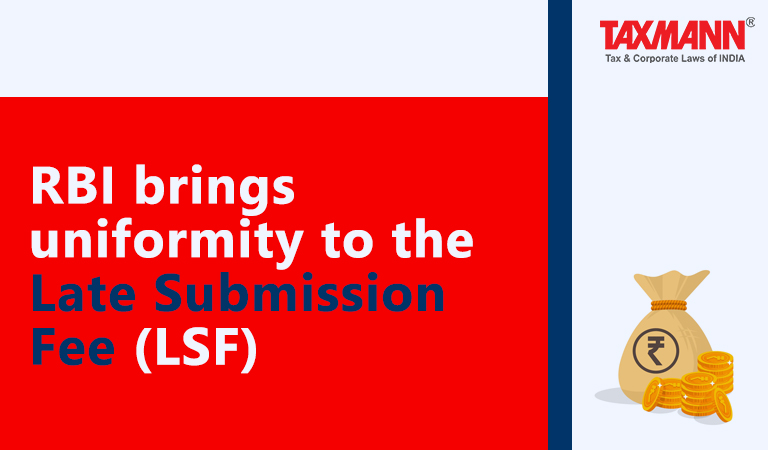RBI brings uniformity to the Late Submission Fee (LSF)
- Blog|News|FEMA & Banking|
- 3 Min Read
- By Taxmann
- |
- Last Updated on 6 October, 2022

Circular No. A.P. (DIR Series) Circular No. 16, Dated 30-09-2022
The reporting delays under the FEMA can be regularised on the submission of the Late Submission Fee (LSF). Before the amendment, different methodologies existed for the calculation of LSF to be paid for various reporting delays. RBI has now decided to bring uniformity in the imposition of LSF across functions. A uniform fee is to be paid for various delays in reporting.
1. How to calculate Late Submission Fee (LSF)?
The following matrix shall be used henceforth for the calculation of LSF, wherever applicable –
(a) LSF Amount shall be calculated at Rs. 7500/- per return for the following types of Reporting Delays –
-
-
-
- Form ODI Part-II/ APR,
- FCGPR (B),
- FLA Returns,
- Form OPI,
- evidence of investment or any other return which does not capture flows or any other periodical reporting
-
-
(b) LSF Amount shall be calculated at Rs. 7,500+(0.025% *amount involved in the delayed reporting* the number of years of delay in submission) for the following types of reporting Delays –
-
-
-
- Form FC-GPR, FCTRS, Form ESOP,
- Form LLP(I), Form LLP(II),
- Form CN,
- Form DI,
- Form InVi,
- Form ODI-Part I, Form ODI-Part III, Form FC,
- Form ECB, Form ECB-2, Revised Form ECB or any other return which captures flows or returns which capture reporting of non-fund transactions or any other transactional reporting
-
-
Further, the number of years of delay in submission would be rounded upwards to the nearest month and expressed up to 2 decimal points.
2. LSF amount is to be calculated per return
The LSF amount is calculated based on delay in filing per return. However, for any number of Form ECB-2 returns, delayed submission for each LRN will be treated as one instance for the fixed component.
Further, the amount involved in the delayed reporting for any ECB-2 return will be the gross inflow or outflow (including interest and other charges), whichever is more.
3. What is the maximum limit up to which LSF can be levied?
As per the RBI’s circular, the maximum LSF amount cannot exceed the amount involved in the delayed reporting.
Further, in the case of the fractional amount, the same will be rounded upwards to the nearest hundred.
4. What is the timeline to opt for LSF?
The facility for opting for LSF shall be available up to 3 years from the due date of reporting/ submission. The option of LSF shall also be available for delayed reporting/submissions under the Foreign Exchange Management (Transfer or Issue of any Foreign Security) Regulations, 2004 and earlier corresponding regulations, up to three years from the date of notification of Foreign Exchange Management (Overseas Investment) Regulations, 2022 (i.e. 22-08-2022).
5. What are the consequences of failing to pay LSF?
In case a person responsible for any submission or filing under the provisions of FEMA, neither makes such submission/filing within the specified time nor makes such submission/filing along with LSF, such person shall be liable for penal action under the provisions of FEMA, 1999.
Also, where an advice has been issued for payment of LSF by the authority and such LSF is not paid within 30 days, such advice shall be considered as null and void and any LSF received beyond this period shall not be accepted. If the applicant subsequently approaches for payment of LSF for the same delayed reporting, the date of receipt of such application shall be treated as the reference date for the purpose of calculating the number of years of delay in submission.
Click Here To Read The Full Circular
Disclaimer: The content/information published on the website is only for general information of the user and shall not be construed as legal advice. While the Taxmann has exercised reasonable efforts to ensure the veracity of information/content published, Taxmann shall be under no liability in any manner whatsoever for incorrect information, if any.

Taxmann Publications has a dedicated in-house Research & Editorial Team. This team consists of a team of Chartered Accountants, Company Secretaries, and Lawyers. This team works under the guidance and supervision of editor-in-chief Mr Rakesh Bhargava.
The Research and Editorial Team is responsible for developing reliable and accurate content for the readers. The team follows the six-sigma approach to achieve the benchmark of zero error in its publications and research platforms. The team ensures that the following publication guidelines are thoroughly followed while developing the content:
- The statutory material is obtained only from the authorized and reliable sources
- All the latest developments in the judicial and legislative fields are covered
- Prepare the analytical write-ups on current, controversial, and important issues to help the readers to understand the concept and its implications
- Every content published by Taxmann is complete, accurate and lucid
- All evidence-based statements are supported with proper reference to Section, Circular No., Notification No. or citations
- The golden rules of grammar, style and consistency are thoroughly followed
- Font and size that’s easy to read and remain consistent across all imprint and digital publications are applied



 CA | CS | CMA
CA | CS | CMA
